A message from the CEO of Tel Aviv Sourasky Medical Center
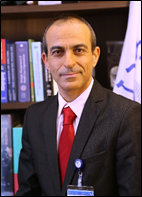
Dear Friends,
The Jewish New Year marks the close of my first year as CEO of Tel Aviv Sourasky Medical Center and my work with the generous supporters and the healthcare team that have made the Medical Center the pride of Israel.
A moment before we start working on our goals for the year ahead, I would like to look back at several mission-critical milestones that we achieved over the past year.
A turning point in patient care
In a single year, we increased the number of ambulatory patient visits by 50,000, and performed 2,000 more surgeries and over 7,000 more imaging procedures than we did the previous year. As patient demand for our world-class care continued to grow, we kicked off our strategic campaign for timely medical services. I am pleased to report that we have dramatically reduced wait lists – at times by months – for certain surgeries, medical tests and procedures.
We were able to improve our responsiveness to patients by working hard, extending service hours, expanding our talent pool and obtaining donated financial resources to fuel progress. Most importantly, your funding and partnership have enabled us to embark on new programs throughout the campus, such as operating four brand-new state-of-the-art linear accelerators for lifesaving radiotherapy treatment.
Over the past year, our research teams published 365 articles in peer-reviewed journals – from quantum leap solutions that reduce elderly patient falls by 40% to breakthroughs in understanding diabetes, immune disorders and cancer.
So much more to achieve
Our commitment for the coming year is to continue to pursue perfection across the medical and research landscape. We have dozens of new initiatives in the works, including programs to expand rehabilitation services exponentially, upgrade maternal and newborn care, streamline outpatient surgeries and personalize cancer care. I invite you to read highlights of these compelling programs online in the Tel Aviv Sourasky Medical Center Vision 2020 booklet.
While we wish that our hospital beds did not need to be occupied and that patients did not need to visit our clinics, we know that our sole purpose is to be the healing force when our patients do need us.
As we stand on the threshold of a year of promise, we are humbled by the faith you have placed in us to comfort, heal and cure, and we appreciate your loyalty to our shared mission. In turn, we pledge to perform at our best. Our success is your success.
Wishing you and your loved ones a sweet New Year.
Prof. Ronni Gamzu
CEO, Tel Aviv Sourasky Medical Center
Greetings from the CEO of Friends of Tel Aviv Sourasky Medical Center
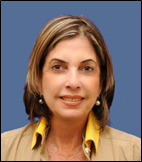
Dear Friends,
With the Jewish New Year upon us, this is the opportunity to reflect on the year that is ending and to take a fresh look at the year ahead.
This past year, we have acted in solidarity with people from countries around the globe as they have become victims of unthinkable terrorism. Here in Israel, we continue to endure stabbings, bombings and shooting attacks. The most recent was the shooting in Tel Aviv’s Sarona Market, where four people were killed and 24 sustained injuries. Most of the injured were treated at Tel Aviv Sourasky Medical Center.
Hagai Klein was seriously wounded in the shooting. Regarding his life-saving care at the Medical Center, he said: “I owe my quick recovery to the devoted medical team… that gave my family and me extensive support.” Tragedies like these reinforce our need for round-the-clock expert emergency medical and trauma care in the Tel Aviv region.
Jewish New Year fundraiser benefits emergency and trauma patients
On September 27th, the Association of Friends held a Rosh Hashanah reception to fund the expansion of the Emergency & Trauma Center. The event, which was hosted by Jonathan Kolber, long-time chairman of the Association of Friends, and his wife Irit, took place at the Claro restaurant and entertainment hall in Tel Aviv’s Sarona Market.
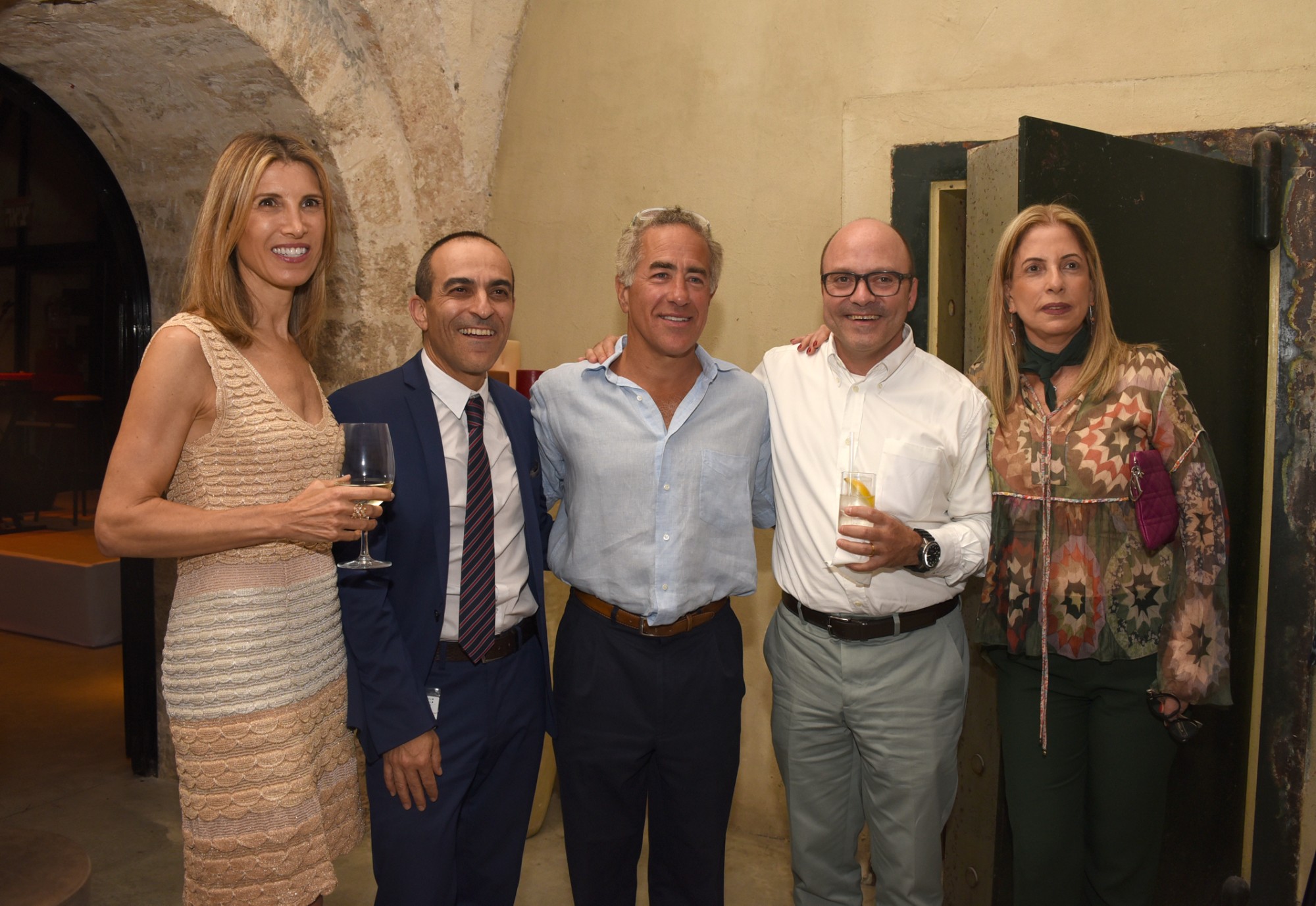
As of publication, the event has raised almost $500,000 toward the $525,000 goal. The funding will add 20 beds to support terror victims, accident casualties and ill patients.
Pictured from left to right: Irit Kolber, Prof. Ronni Gamzu, Silvan Adams, Jonathan Kolber and Ronit Blum
Continuous improvement: A shared effort
In an organization as extensive as ours, making ongoing upgrades in care and services is standard practice. These improvements in quality are bearing fruit, and enhanced services are proving themselves in both inpatient and outpatient settings for adults and children alike. The Medical Center continues to gain international prominence for its achievements and discoveries in medical and scientific research alike.
So much of what we have accomplished – saving patient lives, improving quality of life and remaining on the leading edge of care and research – is thanks to your support. We are eternally grateful for your help in realizing our goals. I trust we can count on you this year to partner with us in our ongoing pursuit of excellence.
I wish you and your family a happy, healthy New Year.
Ronit Blum
CEO, The Association of Friends of Tel Aviv Sourasky Medical Center
Donations
Yarden Gerbi, Israeli Olympic bronze medalist, raises $52,000 for children with cancer
Yarden Gerbi, the judo master who won a bronze medal at the Olympic Games in Rio de Janeiro in August, scored a win for pediatric cancer patients in the Dana-Dwek Children’s Hospital.
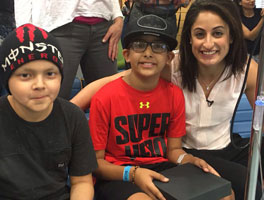
A star on and off the mat
Upon her return from her successful competition, Yarden auctioned the autographed name patch from her judo uniform on eBay and donated the proceeds to the hospital’s Pediatric Hemato-Oncology Department. On a previous visit to the department, Gerbi met and befriended Liran, a young patient under the department’s care. Unfortunately, Liran passed away earlier this year. Liran’s death saddened Yarden, but it also strengthened her resolve to continue helping sick children. “I fight on the judo mat, but in the [cancer] unit, I met real heroes who fight every day to find joy in their young lives,” she said.
French friends team up to launch a new organization to support the Medical Center
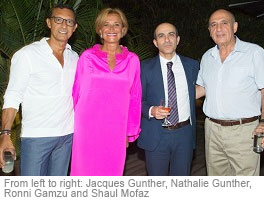
Nathalie Gunther, a Parisian who recently settled in Israel with her family, has taken swift action to support patients in her adopted homeland. After meeting Prof. Ronni Gamzu and learning about the Medical Center’s healthcare mission, she established the French Friends of Tel Aviv Sourasky Medical Center.
Merci to a base of enthusiastic advocates
Nathalie and her husband Jacques recently hosted a group of 80 French Jews, new immigrants and summer-holiday visitors alike, at the organization’s kick-off event.
In his speech at the event, Prof. Gamzu expressed his appreciation to Nathalie on her initiative and collaboration. Dr. Philippe Pucheu, a representative of the French Ministry of Health and visiting physician, also spoke, telling of how impressed he was with the Medical Center’s professionalism, practice and skill, which he discovered first hand during his six-month program to learn about the Medical Center’s best practice emergency response capabilities.
Solidarity with Israelis under threat
In her formal announcement of the French Friends of Tel Aviv Medical Center, Nathalie stressed the importance of donating to and helping support the hospital’s Emergency & Trauma Center, which is on constant alert, prepared to receive and treat victims of terror. The guest of honor, former Israeli minister and IDF Chief of Staff Mr. Shaul Mofaz, praised the initiative and spoke of the need for world Jewry to support Israel, saying that this is Zionism at its best.
An event to honor Ruthie Ram and her $1 million donation toward the Emergency & Trauma Center expansion
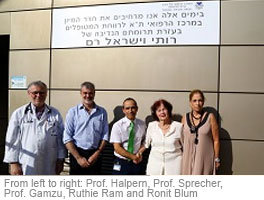
Every year for the past 20 years, as patient visits have continued to rise, the Emergency & Trauma Center has become more and more crowded. Ruthie Ram, a kindhearted long-time donor to the Medical Center, empathized with the hardship that this congestion places on emergency patients and their families. She stepped in to offer short-term relief – supporting a stopgap departmental expansion.
An opportunity to recognize enduring commitment
The Medical Center leadership paid tribute to Ruthie and her late husband Israel in a recent ceremony launching the expansion project. Prof. Ronni Gamzu, Emergency & Trauma Center Director Prof. Pinchas Halpern and Ruthie’s friends and family attended the program.
Prof. Gamzu thanked Ruthie for her friendship and special bond with the Medical Center team and for her continuous support of the Medical Center, emphasizing the importance of her many contributions to mission-critical Medical Center patient care and research initiatives.
The Parasol Women’s Cancer Center: Inspiring women to spearhead the treatments of tomorrow

Among the Jewish population, cancer is more common in women than men due to women’s specific genetic dispositions. Because of this, basic research of cancer among Jewish women needs to leap forward. Ruth Parasol has taken a major proactive step to help balance this inequality. Her generous two-million-dollar donation has founded the Parasol Women’s Cancer Research Center, an investment in bench-to-bedside research and therapeutics targeted to women.
Dedicated to reducing the toll that cancer takes on women
Ruth Parasol says: “The Parasol Women’s Cancer Center will be an inspirational, cutting-edge and innovative center that will enable the top female physicians and researchers in their respective fields to combine their efforts and knowledge to work together to tackle major issues regarding women’s cancers today.”
The initiative to prevent women’s lives from being cut short
The center is breaking ground with new treatment approaches and perfecting existing techniques, such as supercharging natural cancer-fighting cells to recognize and eliminate disease; personalizing treatments of cancerous mutations; cutting off cancer-cell fuel supply and predicting better treatment responses.
The hope is to give women more than a fighting chance to live cancer-free.
“I believe this center will reach new heights and achieve life-changing scientific and clinical breakthroughs,” says Ruth. “We are delighted to be able to be a part of this project.”
The Sylvan Adams Health Science & Rehabilitation Center: Entering a new era in healthcare
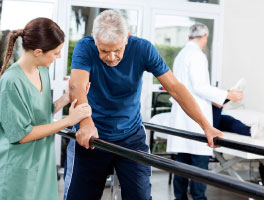
The Medical Center’s reputation for world-class rehabilitation services for patients recovering from serious illness or injury has created a situation in which patient demand far exceeds available space.
A donation that will help shorten patients’ road to recovery
With his generous sponsorship, Sylvan Adams is enabling the Medical Center to extend its quality rehab care. The new Sylvan Adams Health Science & Rehabilitation Center will feature services for neurological, orthopedic, geriatric and respiratory conditions, including physical and occupational therapy, hydrotherapy in a state-of-the-art treatment pool and day program rehabilitation.
Coming full circle for caregivers
To boost the human art of health science, the Sylvan Adams Center will host the Tel Aviv University nursing, physiotherapy, occupational therapy and speech therapy programs, the Sylvan Adams High-Performance Sports Medicine Research Program and the Health Sciences Simulation Center. With these plans and additional donor support for the $30 million facility, the Medical Center will be one step closer to making its health science and rehab vision a reality.
Sammy Sagol partners with the Medical Center in the quest to unlock the mysteries of the human brain
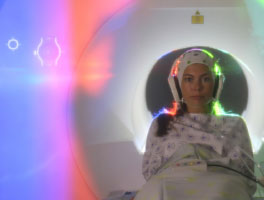
The Sagol Brain Center, founded with a generous donation from Sammy Sagol, will delve into how the human brain functions, working to discover solutions to unsolved neurological and psychiatric conditions.
The Center will be the international nucleus of brain science and medicine, heralding a world-wide revolution in brain health. Enlisting the power of novel imaging techniques, big-data bioinformatics and mobile solutions, the center will transform insights into medical applications. Its goal is to implement non-invasive solutions tailored to each patient. This way, treatment will not be an impossible conundrum, but part of routine care – and prevention technologies will become the standard in medical practice.
Preeminent scientist Prof. Ruth Arnon and Dr. Uriel Arnon donate $1 million to an essential new internal medicine inpatient ward
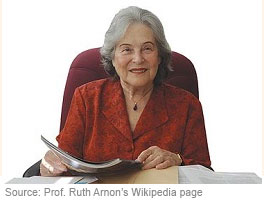
Distinguished Weizmann Institute researcher and Israel Prize recipient Prof. Ruth Arnon and her husband Dr. Uriel Arnon are making a major difference for patients requiring hospitalization for cardiovascular, digestive, neurological and other general medical conditions common to adults. They have donated one million dollars toward the construction of a new 25-bed internal medicine ward that will focus primarily on acute conditions for geriatric patients.
Space for respect: Acute care for geriatric patients
Over recent years, internal medicine services have seen a surge in demand for care by adult patients, mostly senior citizens. Tel Aviv is home to the largest population of older adults in Israel. As people age, they experience more illness and are hospitalized more often.
Ronit Blum, CEO of the Association of Friends of Tel Aviv Sourasky Medical Center, says: “The new Internal Medicine Unit, to be located in the Sammy Ofer Building, will help alleviate the problem of patients waiting for hospital rooms. With its orientation toward geriatric patients, the unit will have close at hand the types of facilities and equipment more commonly needed for aging adults. We are touched by this gift, which will enable us to focus our treatment and care on hundreds of elderly patients every year.”
Donation to enhance hospital accommodations for serious internal medicine cases
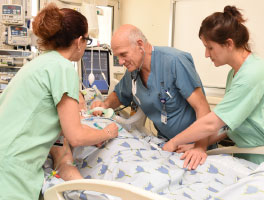
Patients hospitalized in the new Internal Medicine Unit will benefit from a kindhearted donation of two step-down care rooms. These private rooms will offer an intermediate level of care to patients needing special monitoring beyond standard medical support. The room design will feature space for family visitation and special equipment.
What’s new?
Finally, room for patients in the Internal Medicine Unit
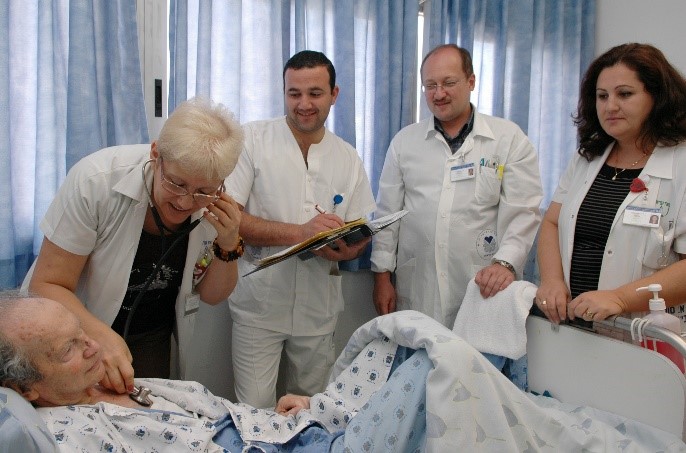
Due to an increasing aging population, the demand for services in the Internal Medicine hospital units greatly exceeds the number of available beds. In an effort to enhance care for each patient treated and reduce overcrowding, the hospital is proactively implementing a quality care action plan to steadily reducing the backlog of patients.
Reaching new levels of patient-centered coordination and planning
The plan incorporates several integrated steps, beginning with increasing the number of beds in the neurology and cardiology departments and teaming up with the Emergency Room on ER admissions and hospitalization alternatives.
In a win-win for patients, Internal Medicine departments are shortening stays for patients who are ready (and eager) to be discharged by accelerating lab results and appointing a nurse to facilitate discharge planning. The department is also expanding the roles of social workers and bringing them in earlier in the process to plan for discharge – especially for complicated cases requiring family and community coordination.
Looking ahead toward a long-term solution
The plan by the year 2018, contingent upon funding, is to accommodate all patients comfortably by opening up a new Internal Medicine floor in the Sammy Ofer building. Prof. Ruth Arnon and her husband Uriel Arnon have graciously donated $1 million to the mission.
Streamlining care in the Emergency & Trauma Care Center
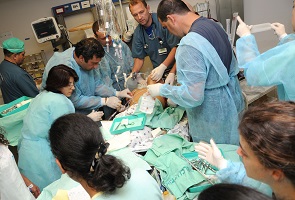 T
T
Thanks to the support of Ruthie Ram and other generous donors, the Emergency & Trauma Center is taking new steps to improve its patients’ care experience. The center is the busiest in the country, coping with a growing, aging and complex patient population from the greater Tel Aviv area. The two-phase project puts immediate enhancements in place while planning for the long term.
Annexation, automation and relocation: A clear plan for the future
Prof. Pinchas Halpern, director of the center, has this to say about the plans: “We will be adding patient care beds in the immediate term by annexing space next to the center currently occupied by the dental clinic, which will be moved to a different part of the campus. By 2020, we plan to construct a spacious new facility with benchmark features such as intensive care and trauma suites, a short-stay unit for patient monitoring and expanded urgent care walk-in services.”
The center will also computerize patient management and introduce state-of-the-art patient tracking, mobile physician data terminals, mobile patient information systems and other technologies. Process improvements such as a structured triage system and strategic coordination between care units will greatly enhanced patient service, quality of care and staff satisfaction in this high-functioning, service-oriented ER.
A champion of patient and visitor health, the Medical Center becomes smoke-free

As leaders in promoting the health of Tel Aviv residents and visitors, Tel Aviv Sourasky Medical Center has gone smoke-free as of June 2016. Smoking is now prohibited throughout the Medical Center campus, including the gardens and courtyards. Designated smoking areas throughout the facility have been removed, while about eight smoking areas have been placed in the back of the campus.
A (nearby) place for staff to call home

The members of our clinical team put their heart and soul into caring for patients, which is why we need to find and retain the best and brightest. The new on-campus, 19-floor Staff Residential Complex, due to be ready in late 2017, will offer 274 apartments at reduced rent and with key family-oriented services. By living within walking distance of work, hardworking employees will have more time at home with their loved ones.
First responders when time is of the essence
The facility’s close proximity to the Medical Center will enable team members to respond immediately to emergency calls, such as terror attacks and mass casualty events, which Tel Aviv has endured so many times.
New medical services
Personalized treatment for oncology patients: Decoding cancer’s genomic profile
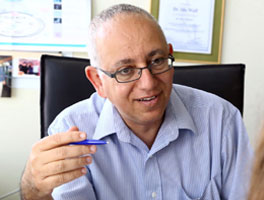
The Medical Center has introduced a breakthrough patient test that provides the most comprehensive, accurate and reliable information available on the genomic profile of cancer cells. FoundationOne works by scanning oncology patient tissue samples to identify variances in the patient’s genes.
Fitting the treatment to the person
Coupled with the most precise information about the cancer’s genomic profile and supported by the latest research, oncologists can personalize treatment for each patient and choose the most effective treatment to fight a specific cancer. “The test gives our specialists access to the largest global database, with up-to-the-minute genome information,” says Prof. Ido Wolf, Director of the Oncology Division. “It allows them to share knowledge related to a patient’s specific genomic profile and communicate with other world-leading medical centers.” The test is offered at a substantially reduced price only to patients of Tel Aviv Sourasky Medical Center.
First in Israel: Novel molecular testing to assess cancer patients’ suitability for immunotherapy

Immunotherapy is a revolutionary personalized cancer treatment that stimulates the body’s own immune system to fight cancer and eliminate diseased cells. It is appropriate only for certain types of tumors, however, and is not an across-the-board fit for all patients.
Revolutionary test to determine treatment candidacy
Tel Aviv Sourasky Medical Center is the first in Israel and among only a handful of medical centers worldwide that are certified to offer an FDA-approved breakthrough immunotherapy-based treatment for melanoma, lung cancer and head and neck squamous cell cancer. KEYTRUDA® (pembrolizumab) is an effective treatment, but only for those patients whose tumor expresses the protein PD-L1. To test for PD-L1 expression, oncologists first perform the PD-L1 expression test, the most reliable test in the field.
Leading the way in Israel
Organizations certified to conduct the test are equipped with state-of the-art technology, including a specially designed robot from Denmark. The testing team follows stringent testing procedures after undergoing extensive training. “Conducting PD-L1 expression testing at the Medical Center is another prominent element that places our center at the spearhead of immunotherapy,” says Prof. Wolf.
Putting patients first: The Oncology Division reduces the patient wait list to two days

“The first 48 hours after receiving a cancer diagnosis are the most difficult for patients and their families,” says Prof. Ido Wolf, Director of the Oncology Division. Patients experience great uncertainty about their prognosis, treatment and recovery prospects during this time. The Oncology Division aims to shorten the wait for an initial appointment with an oncologist so patients can get answers quickly and reduce the stress related to the unknowns.
Setting the benchmark in responsiveness to patients
The Oncology Division’s practice is for patients to see an oncologist within 48 hours from the initial referral. The Radiotherapy Institute has followed suit by striving to cut patient wait times; in urgent cases, the goal is to receive patients and start treatment within 48 hours from referral to the unit.
“This step makes the Oncology Division among the first of Israel’s public hospitals to revolutionize new standards for patient care,” says CEO Prof. Ronni Gamzu. “It is part of our comprehensive strategy across the Medical Center to see patients more quickly for initial appointments, treatment and follow-up.”
New Oncogenetics Clinic helps drive the best personalized treatment option

While all cancers are caused by genetic mutations in cells, only about five to ten percent of cancer cases are thought to be hereditary.
Inborn genetic makeup shines light on therapeutic direction
In the new Oncogenetics Clinic, geneticist oncologists look for mutations in a person’s genes that might increase the risk of cancer. While oncogenetic testing can help detect and prevent cancer early on, it may also have significant advantages for oncological treatment decisions. For example, test results give physicians input into the best type of chemotherapy, choices between chemotherapy and radiation, the extent of surgery, new biological therapies and experimental drugs for patients with specific ancestral DNA.
The Oncogenetics Clinic counsels oncology patients in the same office area where routine follow-up visits take place. This integration, together with direct and open communication with the oncology team, synchronizes the patient’s care experience.
Dynamic discoveries keep patients up to date
Because the field of oncogenetics is evolving quickly, cancer patients can be retested every few years for recently discovered genetic predisposition indicators and more comprehensive results. Fortunately, testing costs are dropping and some exams are reimbursable by insurance.
It is hoped that future developments in genomic technologies will make testing even more affordable so that both patients and their families can be aware of their future cancer risks, develop strategies to reduce them and take appropriate measures for early detection.
A round of applause
Awards
- Prof. Anat Lowenstein, Chair of the Department of Ophthalmology, was chosen as one of the 100 most influential people in the world of ophthalmology in The Ophthalmologist Magazine’s Power List 2016. She received this honor for “her contribution to and influence in the field of medical and surgical retina.”
- Prof. Jeffrey Hausdorff, Director of the Center for the Study of Movement Cognition and Mobility, has become a Fellow of the Gerontological Society of America, a distinguished honor for sharing his expertise and leadership.
Appointments
Congratulations to the following outstanding Medical Center professionals on their recent promotions:
- Dr. Jacob Ablin: Director of Internal Medicine Unit H
- Dr. Nimrod Adi: Manager of the General Intensive Care Unit
- Prof. Foad Azem: Director of Reproductive Health and the IVF Institute
- Dr. Firas Fahoum: Manager of the Epilepsy Service and EEG Institute
- Dr. Gil Fire: Associate Medical Director
- Dr. Orit Golan: Manager of the Mammography Unit
- Dr. Chen Halevi: Manager of the Stroke Unit and the Doppler Institute
- Dr. Dov Hershkovitz: Director of the Pathology Institute
- Dr. Ronit Inbar: Manager of the Nutrition and Dietetics Unit
- Dr. Guy Lahat: Director of Surgical Unit A
- Dr. Jacob Mashiah: Manager of the Pediatric Dermatology Service
- Ms. Ettie Oziel: Director of Nursing and Chief Nurse
- Dr. Jonathan Roth: Manager of the Neurosurgical Endoscopy Unit
- Prof. Oren Shibolet: Director of the Gastroenterology Institute
- Prof. Eli Sprecher: Deputy Director of Patient Safety
- Prof. Ido Wolf: Director of the Oncology Division
- Dr. Tali Yonash: Acting Manager of Neuroradiology and Invasive Neuroradiology
- Dr. Alex Zegerman: Manager of the Post-Anesthesia Care Unit (PACU) in the Anesthesia, Pain and Intensive Care Division
Vision 2020
Envisioning the future in the present
Tel Aviv Sourasky Medical Center’s vision for the future is clearer than ever thanks to the plan recently launched by Prof. Ronni Gamzu. The new Vision 2020 publication presents the new and enhanced services that the Medical Center will provide, as well as the new and renovated campus facilities needed to set this plan in motion. Plan highlights feature the new outpatient surgery center, a best practice in accessibility and service; the new Oncology Center, with personalized patient-centered care; and the new Pediatric Intensive Care Unit, for world-class critical care during the most pivotal moment in a child’s life.
Click on the picture to see an enlargement of this map>>
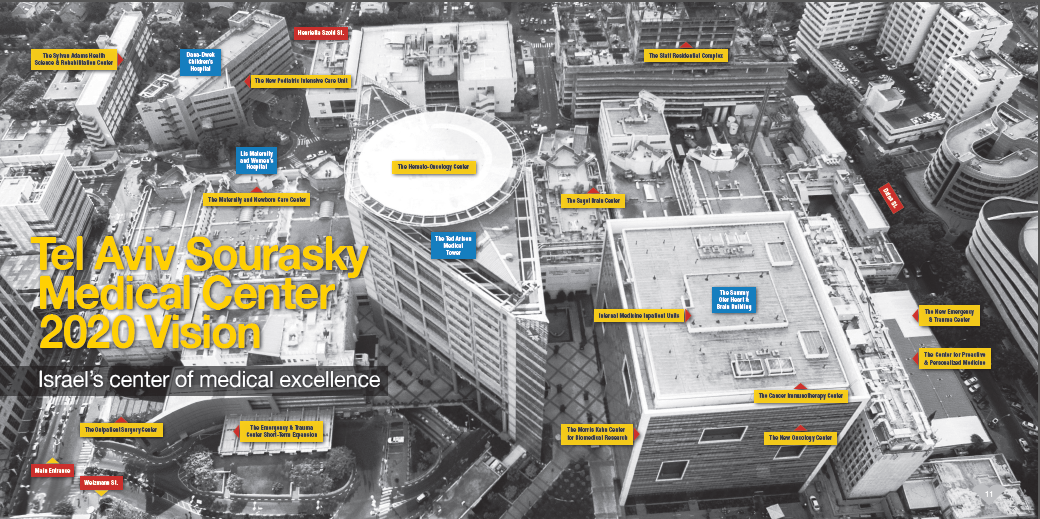
With this vision, the Medical Center can continue to be Israel’s center of medical excellence – serving patients from throughout the country and making significant contributions to the field of medicine worldwide.
Research excellence
A promising direction in preventing and treating type 2 diabetes and metabolic syndrome

Unfortunately, obesity and metabolic syndrome are major epidemics of the current century, affecting about 2.5 billion adults worldwide, which is about 36 percent of the global population.
Research insights break new ground
Emerging evidence indicates that a chronic inflammatory response in fat tissue impairs the cells’ ability to respond to insulin, which can induce type 2 diabetes, fatty liver disease and ischemic heart disease.
The results of a study by Dr. Sigal Fishman, Director of the Obesity Service in the Division of Digestive Diseases and Dr. Chen Varol, Director of the Research Center for Digestive Tract & Liver Diseases, point to a potential therapeutic candidate. Glucose-dependent insulinotropic polypeptide (GIP) is a hormone that stimulates insulin production in the digestive tract, lessening glucose fluctuations after meals. This groundbreaking pre-clinical research by Fishman and Varol shows that GIP can directly act on immune cells to reduce their recruitment to fat tissue, lower their inflammatory activity and improve insulin sensitivity.
Next steps: Developing novel treatments based on GIP
The researchers have made these discoveries thanks to two Israel Science Foundation grants. They are now searching for their next round of funding to gain further insights into GIP and to translate the results into new therapeutics that could lead to a worldwide reduction in obesity and diabetes.
Making headway on primary biliary cholangitis, the most common liver-related autoimmune disorder
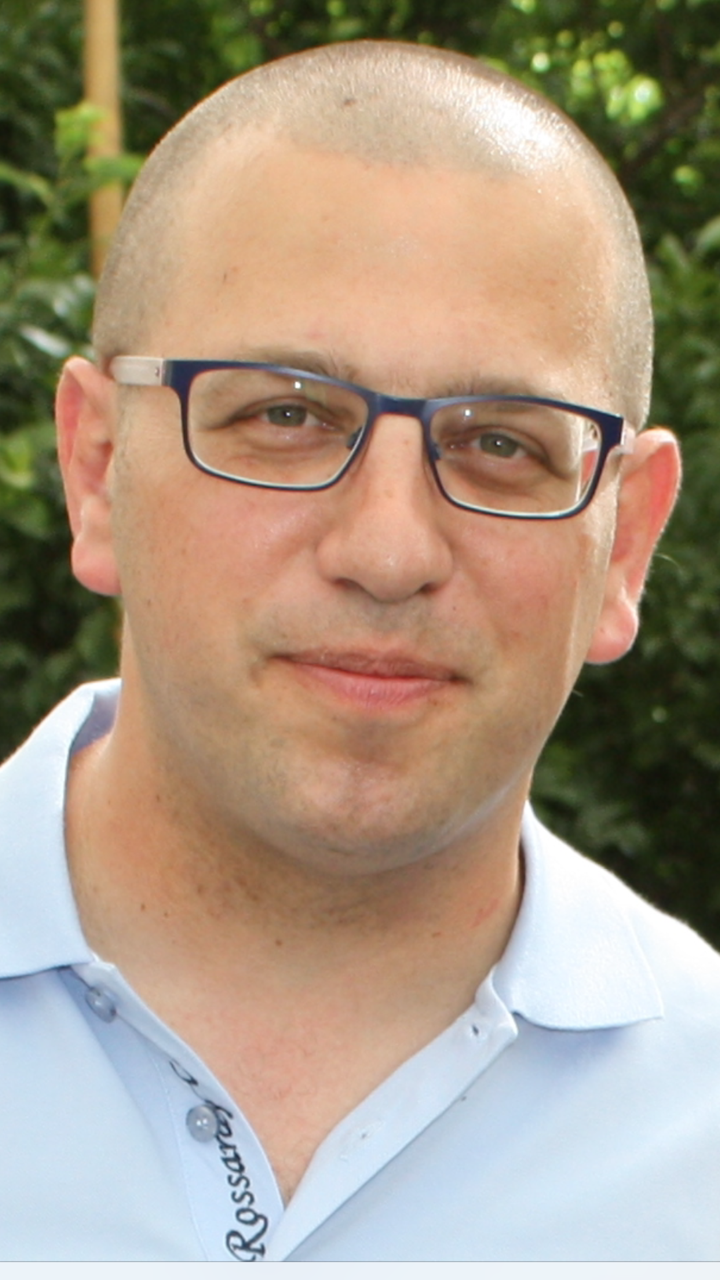
PBC is a chronic progressive autoimmune liver disease that destroys the bile ducts and leads to cirrhosis and liver failure. PBC, which primarily affects women in their fifties to seventies, does not have many treatment options. The causes of the condition are wide open, and could be due to genetic, environmental, infectious, metabolic and/or immunological factors.
Immune system cells could hold the key to PBC treatment
Genome studies currently point to the role of malfunctioning mononuclear phagocytes, which are inherited immune system cells in patients with PBC. Dr. Ehud Zigmond, Senior Physician and Principal Investigator in the Gastroenterology Institute’s Liver Unit and the Research Center for Digestive Tract & Liver Diseases, leads the team that has uncovered part of the role of mononuclear phagocytes in liver diseases.
Going full speed ahead, the researchers will study the genetic predisposition and environmental exposure risk factors related to mononuclear phagocytes that impact PBC. Dr. Zigmond is optimistic. “Successful study discoveries could help deliver potential therapeutic intervention targets for PBC and other chronic liver diseases related to the bile ducts,” he says.
Innovative restorative hydrogel can reverse paralysis
Nerves resemble electrical cables, transmitting energy signals throughout the nervous system. If they are severed or damaged, they cannot transfer power and lose their ability to relay signals for movement and sensation. While some body tissues and organs can regenerate after being damaged, others, such as nerves, are either irreparable or slow to recover. This problem affects hundreds of thousands of people who suffer from peripheral nerve or spinal cord injuries that cause continuous pain, limited mobility or paralysis.
Nerve repair opens up a world of possibilities
An innovative hydrogel implant is being developed to increase nerve growth and recovery, restoring the functionality of torn or damaged nerves. Prof. Shimon Rochkind, Director of the Division of Peripheral Nerve Reconstruction, and a Tel Aviv University colleague have collaborated to develop Guiding Regenerative Gel (GRG), which, in pre-clinical studies, has been found to improve peripheral nerve recovery and restore function in the paralyzed limb. A variant, AGRG, was found to both promote spinal cord reconstruction and partial movement restoration in the paralyzed limb.
The team will advance research to the clinical stage, hoping to apply these solutions to improve function and restore sensation to the broad range of patients suffering from nerve damage due to traumatic injury.
Deciphering pemphigus, a life-threatening condition prevalent among individuals with Jewish heritage
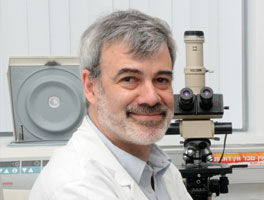
Pemphigus is a serious autoimmune disease in which a person’s immune system turns against his or her own normal skin. Without treatment, most patients die of their disease, which causes skin blisters and oral ulcers. Steroids and other immunosuppressive treatments have reduced mortality rates dramatically, but at the cost of potentially serious side effects. If fact, most of the people who die from the disease (about 10 percent) succumb to treatment side effects, underscoring the need for novel therapeutic strategies and drug targets. Pemphigus is particularly prevalent among individuals of Jewish origin.
Danger due to the skin cell defect
In a 10-year-long study, Prof. Eli Sprecher, Director of Dermatology, and his colleagues, have shed new light on the genetic foundations of the disease. The culprit is a genetic variation that increases expression of the ST18 protein in the skin, resulting in inflammation and destabilization of skin-cell adhesion.
Prof. Eli Sprecher comments on the team’s findings: "The importance of our discovery goes far beyond deciphering the cause of the disease. Until today, autoimmunity research has focused on understanding immune system malfunction. This study shows that abnormal function of the target organ (in our case, the skin), not only of the immune system, contributes to autoimmune diseases."
The next challenge will be to translate these findings into novel skin-targeting therapeutics. The effort may be great, but well worth it, given patients' suffering and mortality.
Augmenting treadmill training with virtual reality prevents falls
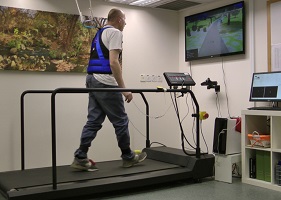
Falls are a serious health issue among older patients, particularly those with neurologic conditions. Paving the way for new fall-prevention initiatives for senior citizens, a program conducted by Tel Aviv Sourasky Medical Center in five European centers showed that when combining treadmill training and virtual reality (VR), patients experienced fewer falls than with treadmill therapy alone. They also had reduced fall risk, as measured by less variation in gait, and performed better on a balance and mobility assessment.
A simple yet sophisticated setup
Enhancing a standard rehabilitation treadmill, the VR system featured a camera that captured motion and a computer-generated simulation projected on a large screen directly in front of the patient. As patients walked on the treadmill, the screen displayed real-life situations such as distractions, obstacles and multiple pathway choices, all of which required the patients to respond by adjusting their steps.
A two-part neurological and cognitive solution
Dr. Anat Mirelman, Associate Director of the Center for the Study of Movement Cognition and Mobility, who headed the study, describes the unique nature of this dual-intervention approach. “Instead of focusing training strictly on risk factors, such as physical strength training, the VR component offers cognitive training as well. Since many neurological conditions impact both motor and cognitive skills, this approach covers both bases, which may explain the program’s successful outcomes.” The program has important potential applications for health, safety, mobility and independence in older adults.
Joining forces with Biogen in the fight against Parkinson’s disease

In a first-of-its-kind program in Israel, the Neurology Division and the Genetics Institute are collaborating with Biogen, a global biotechnology company, on extensive Parkinson’s disease research. The Neurology Division will recruit hundreds of Parkinson’s disease patients and their families to participate in a series of research studies, including the establishment of an extensive, state-of-the-art bio-repository, which will be housed in the Genetics Institute.
The first step in detecting, treating and preventing Parkinson’s disease: Understanding its clinical course and genetic roots
This research, which will continue and expand upon studies initiated with funding from the Michael J. Fox Foundation, will focus on early diagnosis, disease-development characterization and biomarkers associated with disease progression. It is expected to advance the understanding of how genetics contribute to the condition. Prof. Nir Giladi, Director of the Neurology Division and a world-renowned Parkinson’s disease researcher and physician, says: “We hope that these studies will lead to novel research and better insight into the natural history of Parkinson’s disease and potentially drive the development of new medications, including approaches that will hopefully slow or stop disease progression, if not prevent it altogether.” Prof. Avi Orr-Urtreger, Director of the Genetics Institute, highlights: “This combined clinical and genetics research program will further enhance our abilities to tailor personalized treatments and develop new therapeutic modalities.”
CEO Prof. Ronni Gamzu says: “Biogen chose the Medical Center for its prominent role in Parkinson’s disease research and treatment. This exclusive collaboration will position the Medical Center among the leading and most influential institutions in the world for Parkinson’s disease.”
